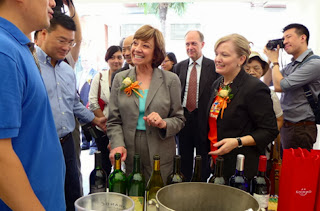Garlic and Onions will not be planted in Federal Water Districts
 |
| Bob Ehn |
 |
| Bob Ehn |
Vietnam Holds Great Prospects for California
 |
| CDFA Secretary Karen Ross (fourth from right) at a trade meeting in Vietnam. Richard Matoian of the American Pistachio Growers is two spots to her right |
California Dreaming in Shanghai
 |
|
CDFA Secretary Karen Ross chats with an exhibitor at the first
California Week. The US Consul General in Shanghai Robert Griffiths
(behind Secretary Ross) was also present.
|
 “The wine industry, by and large, has weathered the worst of the economic downturn of this decade,” said Robert Smiley, professor and dean emeritus of the UC Davis Graduate School of Management.
“The wine industry, by and large, has weathered the worst of the economic downturn of this decade,” said Robert Smiley, professor and dean emeritus of the UC Davis Graduate School of Management.
“Water 360” to Strengthen Integrated Water Management
TODAY, DWR issued “A Commitment to Action,” proceedings from California’s first integrated water management (IWM) summit held recently. “Water 360,” a campaign designed to use IWM to strengthen the efforts of California’s water management community, was launched at the summit
 |
| Yoreme Alma Grande on Lassen Ave. in Huron, CA |